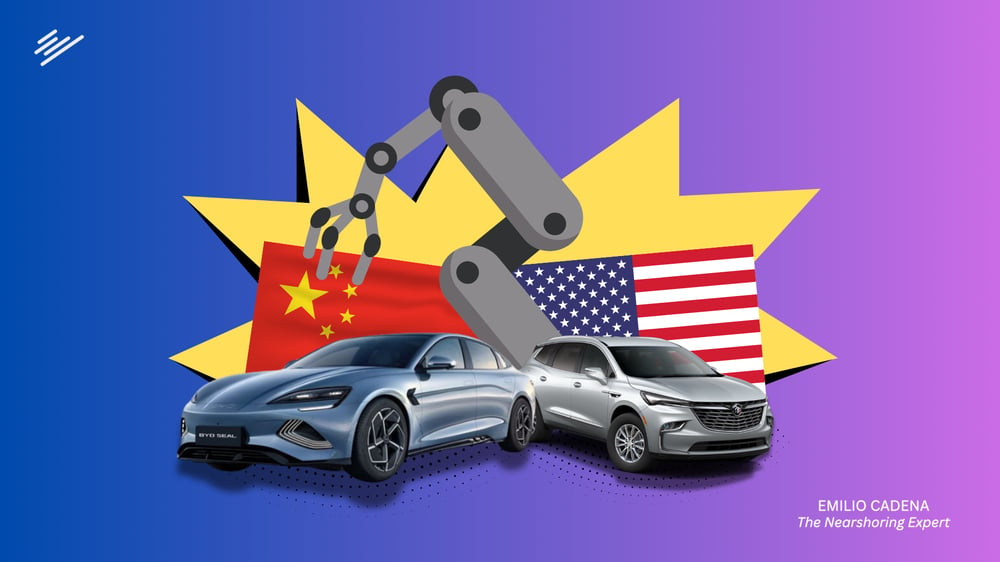The Challenge of Chinese Cars Under the USMCA: Will They Comply with the Restrictions for the North American Market?
Feb 4, 2025 5:13:13 PM 5 min read

The automotive industry in North America is at a pivotal moment, with all eyes closely watching Chinese car manufacturers work to navigate the opportunities and challenges posed by the United States-Mexico-Canada Agreement (USMCA). Nearshoring has become a key strategy in the evolving landscape, with these companies keen on establishing factories in Mexico to meet the USMCA's stringent rules of origin, granting them access to the lucrative U.S. market. However, recent U.S. policies aimed at safeguarding national interests-particularly in areas like steel, aluminum content, and vehicle connectivity technology-pose significant hurdles for these efforts.
Rules of Origin and Competitiveness Under the USMCA
The USMCA's rule of origin demand that vehicles seeking preferential treatment must include at least 75% regional content, a benchmark that is among the highest in global trade agreements. Additionally, vehicles must comply with stricter labor standards and use steel and aluminum sourced from the region. According to an analysis by the Mexican Automotive Industry Association (AMIA), meeting these requirements could enable Chinese-origin vehicles assembled in Mexico to avoid additional tariffs when entering the U.S. market.
Despite these provisions, there is mounting political pressure in the United States to limit the entry of Chinese-origin vehicles, as increase production by Chinese companies in Mexico is perceived as a threat to the competitiveness of the U.S. automotive industry.
However, the reality is that Chinese companies make up very little of the overall investment in the sector. Between 2006 and 2023, 33 Chinese companies operating in the sector made up only 4% of automotive foreign direct investment. The fears of a "Chinese invasion" are overstated.
Short-Term Scenario
In September 2024, the U.S. Department of Commerce announced plans to ban key Chinese software and hardware in connected vehicles on U.S. roads, citing national security concerns. If finalized, these restriction, which would take affect for 2027 model year vehicles (for software) and 2029 model year vehicles (for hardware), would affectively block the entry of Chinese cars and trucks into the U.S. market.
For global automakers, this means carefully examining their supply chains to eliminate Chinese components that could violate these new regulations. While these decisions are framed as national security measures, their ripple effects could complicate efforts to bring vehicles with Chinese technology into compliance with the USMCA. We may also see a USMCA panel review whether these restrictions align with the treaty's rules.
Mid-Term Scenario: The 2026 USMCA Review
Looking ahead, the 2026 USMCA review will be a critical moment for the automotive sector. During this joint evaluation by the USMCA countries, a key focus will be the operation of rules of origin within the automotive sector. In particular, there will be discussions around the challenges posed by China's designation as a "non-market economy" and its potential impact on the region's competitiveness.
Senior USMCA trade officials have agreed to collaborate on issues related to non-market economic practices linked to China. The U.S. Trade Representative (USTR) has already expressed concerns about Chinese electric vehicle manufacturers aiming to leverage Mexico as a base to access the U.S. market. We might see this ultimately leading to additional restrictions on Chinese vehicle production in Mexico, even for companies meeting regional content requirements. 
Outlook and Challenges for Mexico's Automotive Industry
Mexico's automotive industry faces both optimism and uncertainty. On the one hand, attracting investment from Chinese companies could boost local economies and strengthen regional supply chains. On the other, the political climate in the United States, combined with new national security policies, could dampen these opportunities.
There is some cause for optimism. Projects to produce electric vehicle batteries in Mexico are already underway, which could bolster regional content levels and reduce dependence on external inputs. However, there is a constant element of unpredictability in the landscape.
2026 USMCA Review Will Be Key
The presence of Chinese cars in Mexico presents both opportunities and challenges under the USMCA. While nearshoring and meeting the rules of origin could provide a pathway to access the U.S. market, additional hurdles-such as technological restrictions and political pressures-must be navigated carefully.
The 2026 USMCA review will be crucial in determining whether the agreement adapts to the new market realities and how trade tensions between North America and China will be managed.
For automotive companies, particularly those operating in Mexico, the strategy must include careful planning to respond to regulatory changes and optimize supply chains in alignment with regional requirements.
